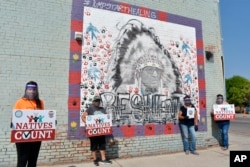This website uses cookies so that we can provide you with the best user experience possible. Cookie information is stored in your browser and performs functions such as recognising you when you return to our website and helping our team to understand which sections of the website you find most interesting and useful.

Here are some Native American-related news stories that made headlines this week:
Report: States’ efforts slowing inclusion of race, ethnicity in school teachings
Native American history and cultures have long been left out of American history lessons. Just as U.S. school systems have been redesigning curricula to be more inclusive, the anti-critical race theory (CRT) movement is working to make sure that race, ethnicity, national origin, gender and color are never discussed in U.S. classrooms, The Nation reports.
One hundred ninety-five “educational gag orders” have been introduced in 41 state legislatures since January 2021, according to the nonprofit PEN America. Fifteen states have laws in place, and seven of them censor CRT at the college/university level. These include states such as South Dakota, which have large Native American populations.
CRT is a decades-old academic concept that racism is built into U.S. legal and government systems. In recent years, it has come to be applied to any teaching of America’s racist history, which critics believe creates conflict and places unfair blame on white Americans for the actions of their ancestors.
The American Civil Liberties Union says CRT laws are “thinly veiled attempts to silence discussions of race, gender, and sexuality,” which “suppress free speech.”
Read more:
Montana judge upholds lawsuit on state failure to fund, teach Native history
A Montana judge refused this week to dismiss a lawsuit accusing the state of violating its constitution by failing to teach Native American history and culture to public school students.
Montana is home to seven Indian reservations and eight federally recognized tribes. In 1972, the state amended its constitution, requiring public school teachers to consult with tribes and give instruction about the Indigenous peoples of the state.
In 2007, Montana legislators allocated $3.5 million annually to support Indian education. The current lawsuit, filed in 2021, claims that nearly half of allocations for 2019 and 2020 are unaccounted for.
The state tried to have the case dismissed, but the judge upheld the lawsuit, saying she would explain her reasons next month.
Read more:
Report: University of Minnesota guilty of ethnic cleansing
A three-year study of the history of the University of Minnesota and its relationship to Native tribes shows how the school was founded on proceeds of land tribes were forced to cede in the 19th century.
A new report, “Towards Recognition and University-Tribal Healing,” or TRUTH, sheds light on the Morrill Act, signed by President Abraham Lincoln in 1862, that allowed states to establish public colleges paid for by developing land tribal communities had been forced to cede in previous decades.
Digging through archives, a team of researchers found that the U.S. paid $2,309 for 94,631 acres of formerly Dakota and Ojibwe land. The university sold that land and raised nearly $580,000 by the turn of the 20th century, equivalent to more than $18.4 million in 2021.
“The Founding Board of Regents committed genocide and ethnic cleansing … for financial gains,” the authors state, adding that they also “used their positions in government to pass anti-Indigenous legislation that benefited them and the institution financially.”
Authors are calling on the university to formally acknowledge its wrongs and take steps toward healing that include reparations, truth telling and policy changes.
Read the report here:
Yale Launches Cherokee Language Course
Beginning next fall, Yale University will offer a Cherokee language course that will count toward academic credit.
As Native News online reported this week, Yale has offered informal courses in a variety of indigenous languages via its Native American Cultural Center and the Directed Independent Language Study program. But these did not satisfy the foreign language study required in many degree programs.
Read more:
1,000-year-old Indian canoe raised from North Carolina Lake
A team of archaeologists, assisted by members of the nearby state-recognized Waccamaw Siouan Tribe, this week raised an ancient Native American canoe out of a lake in southeastern North Carolina (see video above).
State archaeologists say the canoe is about 1,000 years old, dating to a time when a number of tribal groups lived in the region.
Two teenagers discovered the canoe while swimming in Lake Waccamaw in 2021. They notified state archaeologists, who moved the canoe closer to the shore and stabilized it.
VOA reached out to John Mintz with the North Carolina Office of State Archaeology for details.
“We submitted [a sample] to a lab for carbon-14 dating. The numbers came back between 960 and 940 BCE, so we rounded it up to about a thousand years old,” Mintz said.
He explained how the 28-foot dugout canoe survived so long underwater without rotting.
“Wood, once it’s immersed in water or mud or a combination thereof, can reach a certain equilibrium where there’s no more degradation, no more rot. It can just stay that way — obviously for a thousand years or more,” he said. “But once wood is brought up out of that medium and begins to dry, it will rot before your eyes.”
Archaeologists placed the canoe into a specially designed tank full of water. Over time, Mintz said, conservationists will draw the water out and replace it with a chemical bonding agent to hold the wood together.
Read more:



 Africana55 Radio
Africana55 Radio 



